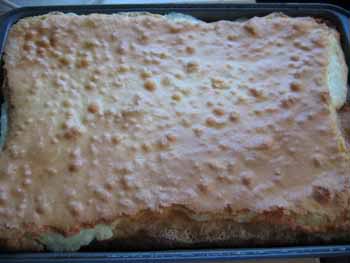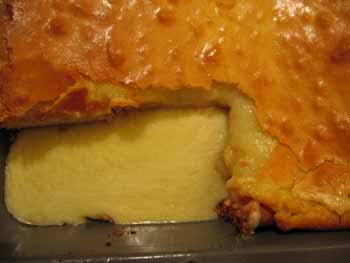
There are a few things I don’t like to eat (well, more than a few), and most of them center around dairy products: Yogurt. Most cheeses. Sour cream. Plain milk. You get the picture. If it’s too creamy, too tangy, too unctuous, I’ll put my hand over my plate and say No, thanks. S, on the other hand, is a dairy farmer’s dream: he can’t get enough of the stuff. Perhaps this explains his high cholesterol.
When S first discovered my love of baking, he eagerly described to me a delicacy of his south Jersey childhood, a treat his father introduced to him called Philadelphia German Butter Cake. I’d never heard of it, which surprised me—I’m a wee bit vain about my knowledge of regional food specialties, at least in the northeast—but S made it out to be something of a touchstone for him, the food item that encapsulated memories of his youth, but one he hadn’t tasted in decades. A Madeleine, a Rosebud. Dare I say it: a Holy Grail.
I did some research and found a recipe online, and baked it as a gift for our first Hanukkah together. During the preparation I became distraught more than once, convinced that either the recipe was wrong or I’d made some horrible mistake. The cake never seemed to bake through; the top layer was a pretty golden brown but even the slightest movement left it shaking and rippling like loose jello. When the edges were on the verge of burning I pulled it from the oven and left it to cool. Twenty minutes later I returned and nearly cried: the center had collapsed entirely, like a soufflé that’s been banged on a counter. When I presented it to S, it was more to show him that I’d tried, not because I thought he’d actually like it.
The man nearly died with happiness. Who knew—this is exactly what a Philadelphia German Butter Cake is supposed to look like. Eagerly, he cut into it. A great rush of buttery goo oozed out from the wound. I was appalled; S was thrilled.

He ate enthusiastically that December, polishing off an entire 9 x 13 cake in a matter of days. I declined to taste it—it looked a little too much like bodily fluids to me, and besides, if it turned out I liked it that wouldn’t exactly be a good thing anyway. I’d only eat it, and trust me, this is devastatingly fattening. It’s called BUTTER CAKE, for crying out loud. After that happy Hanukkah, S and I agreed this particular treat should be reserved for only the most special occasions.
The Eagles making the Superbowl after a 24-year drought surely counts as such an occasion. S doesn’t watch much sports, and had only followed the team’s march to victory through his brother’s excitement, but when an epochal event like this happens, you just can’t pass it by. As I type S is driving down to his brother’s in south Jersey, Butter Cake on the seat beside him. The plan is to watch the game at the local pub, along with thousands of other eager, on-their-way-to-drunk fans, eat chicken wings, and gorge on Butter Cake.
I figure, if I only have to bake it once every 24 years, that’s fine with me.

Last night S had to “sample” the cake, to make sure it was good enough to take down to its Land of Origin. He started out eating like a regular human, with a decent-sized forkful…

…but once he got a taste of that gooey, disgusting cake, he was a goner.
Philadelphia German Butter Cake
[I found the same recipe on at least a dozen sites, so I don’t know who deserves the credit, exactly…]
Serves 10-12
For the Cake:
¼ cup sugar
¼ cup vegetable shortening (not butter flavored)
¼ t. salt
1 large egg
1 envelope active dry yeast [I used 2 t. SAF instant yeast]
½ cup warm milk [110 degrees, if you’re using active dry yeast & have a thermometer]
2 ½ cups all-purpose flour
1 T. pure vanilla extract
For the Topping:
½ lb unsalted butter (2 sticks)
2/3 cup flour
2 cups extra finely granulated sugar [I put 2 c. sugar in my food processor and whiz it around for a few seconds]
2 large eggs
4-5 T. milk
Make dough:
If using active dry yeast, dissolve in warm milk and set aside to proof. [If using instant yeast, skip this step.]
With a mixer, combine sugar, shortening, and salt. Add egg and beat 1 minute. Add flour, then milk/yeast mixture and vanilla to sugar mix. [If you’re using instant yeast, combine it with the flour first.] Mix 3 minutes with dough hook or by hand.
Turn dough out onto floured board and knead 1 minute. Put into a lightly greased bowl, turning to coat dough. Cover bowl with plastic wrap and set in a warm place to rise for 1 hour or until doubled in bulk.
Meanwhile prepare the topping:
Cream butter. Stir together flour and sugar. Gradually beat sugar/flour mixture into butter. Add eggs, one at a time, beating well after each addition. Add milk by teaspoonful to bring the mixture to an easy spreading consistency. Do not make it too runny.
When dough has doubled in size:
Preheat oven to 375.
Decide if you’ll be using two well-greased 8-inch square pans, or one 9×13-inch pan [I use one big one]. If using two pans, divide dough in half. Roll or pat dough to fit bottom of pan(s). Crimp edges half way up the pan to hold the topping.

Prick dough well with a fork to prevent bubbling.

Put topping on cake, and spread over the dough. Let cake rest for 20 minutes.

Bake for 25-30 minutes or until done. Do not overbake: topping should be crusty but gooey.

Let the cake cool before cutting. The center will sink considerably—don’t be alarmed; according to S this is perfectly normal.
